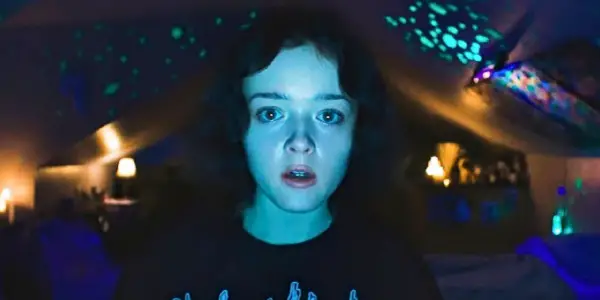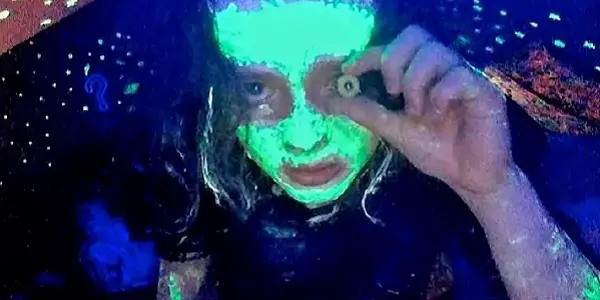WE’RE ALL GOING TO THE WORLD’S FAIR: Jane Schoenbrun’s Cinematic Dysphoria

Lee Jutton has directed short films starring a killer toaster,…
The act of wrestling with one’s identity as a teenager is a universal concept that has been depicted in coming-of-age movies for decades. Yet the act of wrestling with those feelings of dysphoria and unreality that can affect members of the transgender community has barely been seen on screen at all. Nonbinary filmmaker Jane Schoenbrun is changing that with their incredibly inventive first narrative feature as writer-director, We’re All Going to the World’s Fair.
Drawing on Poe’s Law, an adage that posits that it is impossible to know if someone is telling the truth or trolling you online, We’re All Going to the World’s Fair tells the story of a teenage girl who becomes deeply immersed in an online role-playing game. And indeed, those of us who grew up with the Internet (even in its earliest days) know what a tempting refuge it can be when you are deeply unhappy with yourself. Behind the anonymity of a username and an avatar, in chat rooms and on message boards, we can be anyone we want—and in doing so, we can (hopefully) figure out who we really are.
Yet where one seeks (and often finds) comfort, one can also find horror. Schoenbrun utilizes the hyper-specific language of the Internet—in particular, the dark world of creepypasta—to weave an engaging and frightening tale, featuring a remarkable debut performance from Anna Cobb, that should deeply affect audiences regardless of one’s gender identity.
Terminally Online
The game is simple: repeat three times in the ominous glow of your computer screen, “I want to go to the world’s fair.” Then, prick your finger, wipe the blood on the screen, and watch the video—and document for others on the Internet what happens next.
Casey (Cobb), a quiet girl living in an attic bedroom covered with blacklight posters and other common signifiers of being an “alternative” teen, decides to play the game. When she’s not scrolling through endless videos of other World’s Fair players describing how the game has changed the way they feel in their own bodies—from someone who claims to feel as though he is playing Tetris inside his digestive tract to another who picks away at the clay rot crawling up his arms, to another who claims their body is gradually becoming plastic—she’s documenting her own experiences.

Casey describes moments of feeling as though she is watching herself from outside of her own body. She sets up a camera to record herself sleeping, only to capture what appears to be a moment of potential demonic possession. She sings and dances a goofy song about how much she loves winter, only to dissolve into painful, panicked shrieks. She even contemplates the gun her father keeps in the shed and claims that someday, she’ll just disappear.
These moments, depicted by Schoenbrun as though we too are watching them on our computer screens in the dark recesses of some creepypasta forum, are the freaky, fascinating heart of We’re All Going to the World’s Fair, in large part due to Cobb’s wonderful performance. One particularly painful scene, in which she paints her face and has a violent encounter with a beloved childhood toy, is guaranteed to break your heart.
Time to Log Off
Casey’s increasingly disturbing videos catch the eye of a self-appointed World’s Fair watchdog known only as JLB (Michael J Rogers); he is as obsessed with uncovering the secrets of the game as Casey and others are with weaving their own versions of them through their video diaries. Anyone who has ever been young online will recognize Casey’s initial desire to be seen and understood by JLB, as well as her increasing disgust with this adult man’s willingness to engage with a teenage girl online. JLB thinks there’s something wrong with her, and that she needs help, but in Casey’s view, he’s the one with a problem—one that she diagnoses in an intense video that somehow manages to use a tarot reading as a subtweet with great effect.

Despite him being an archetype that all too many audience members will understand, it is JLB’s increased presence throughout We’re All Going to the World’s Fair that is the film’s biggest weakness. During many of his scenes, we actually come out from behind the screen and enter his expansive, empty, lonely home—but these scenes feel jarring and unwelcome in a narrative that is otherwise expertly crafted through devices that imitate both the creation and viewing of online videos.
When we feel as though we are JLB, watching Casey through our screens and growing increasingly uncomfortable with her videos (not to mention our own role as onlookers), it’s much easier to be swallowed up by the story and legitimately scared by the directions it seems to be going in. This is further emphasized by Daniel Patrick Carbone’s haunting, atmospheric cinematography and Alex G’s lo-fi score, which adds a strangely lovely undercurrent of sadness to the proceedings.
Is Casey really being somehow supernaturally changed by the World’s Fair game, or are her videos merely small pieces of the game’s larger world-building? Are these videos a cry for help, or are they providing her with an outlet to express her darkest and most distressing feelings so she won’t act them out in real life? We’re All Going to the World’s Fair gives you plentiful opportunities to come to your own conclusion, only for something else to occur a moment later that turns all of your expectations entirely upside-down—which is why the rather straightforward ending is somewhat of a letdown. Regardless, the World’s Fair is a place worth visiting yourself if given the chance.
Conclusion
As a cisgender woman, I know that I cannot connect with We’re All Going to the World’s Fair in the exact same way a transgender audience member would. Yet watching Casey and her fellow game players describe being trapped in their own bodies, or otherwise not entirely in control of what was happening to them, still deeply resonated with me and my own memories of teenage awkwardness and confusion. I know what it’s like to be uncomfortable with yourself and to try and seize control of your own narrative through the anonymity of the Internet, whether it be crafting elaborate fictions and publishing them online or pretending to be someone else in a chat room. In their director’s statement, Schoenbrun says that they hope this film makes people like them feel less alone; in a world where trans kids are the target of more and more discriminatory legislation every day, I hope so too.
What do you think? Are you familiar with creepypasta? Share your thoughts in the comments below.
We’re All Going to the World’s Fair opens in select theaters in the U.S. on April 15, 2022. It expands to theaters nationwide and digital platforms on April 22, 2022.
Watch We’re All Going to the World’s Fair
Does content like this matter to you?
Become a Member and support film journalism. Unlock access to all of Film Inquiry`s great articles. Join a community of like-minded readers who are passionate about cinema - get access to our private members Network, give back to independent filmmakers, and more.
Lee Jutton has directed short films starring a killer toaster, a killer Christmas tree, and a not-killer leopard. Her writing has appeared in publications such as Film School Rejects, Bitch: A Feminist Response to Pop Culture, Bitch Flicks, TV Fanatic, and Just Press Play. When not watching, making, or writing about films, she can usually be found on Twitter obsessing over soccer, BTS, and her cat.













